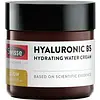What's inside
What's inside
 Key Ingredients
Key Ingredients

 Benefits
Benefits

 Concerns
Concerns

 Ingredients Side-by-side
Ingredients Side-by-side

Water
Skin ConditioningGlycerin
HumectantNiacinamide
SmoothingCaprylic/Capric Triglyceride
MaskingGlyceryl Stearate Se
EmulsifyingCetearyl Alcohol
EmollientPropanediol
SolventZinc Sulfate
AntimicrobialCeramide AP
Skin ConditioningCeramide EOP
Skin ConditioningCeramide NP
Skin ConditioningBenzyl Alcohol
PerfumingCeteareth-20
CleansingMagnesium Aluminum Silicate
AbsorbentParfum
MaskingHydroxyethylcellulose
Emulsion StabilisingXanthan Gum
EmulsifyingDimethicone
EmollientDehydroacetic Acid
PreservativeCitric Acid
BufferingSodium Citrate
BufferingSodium Lauroyl Lactylate
EmulsifyingPhenoxyethanol
PreservativePhytosphingosine
Skin ConditioningCholesterol
EmollientCarbomer
Emulsion StabilisingEthylhexylglycerin
Skin ConditioningHydroxycitronellal
PerfumingGeraniol
PerfumingLinalool
PerfumingWater, Glycerin, Niacinamide, Caprylic/Capric Triglyceride, Glyceryl Stearate Se, Cetearyl Alcohol, Propanediol, Zinc Sulfate, Ceramide AP, Ceramide EOP, Ceramide NP, Benzyl Alcohol, Ceteareth-20, Magnesium Aluminum Silicate, Parfum, Hydroxyethylcellulose, Xanthan Gum, Dimethicone, Dehydroacetic Acid, Citric Acid, Sodium Citrate, Sodium Lauroyl Lactylate, Phenoxyethanol, Phytosphingosine, Cholesterol, Carbomer, Ethylhexylglycerin, Hydroxycitronellal, Geraniol, Linalool
Water
Skin ConditioningDimethicone
EmollientNiacinamide
SmoothingGlycerin
HumectantDimethicone/Vinyl Dimethicone Crosspolymer
Skin ConditioningButylene Glycol
HumectantCetearyl Olivate
Sorbitan Olivate
EmulsifyingPanthenol
Skin ConditioningIsononyl Isononanoate
EmollientSodium Hyaluronate
HumectantPalmitoyl Pentapeptide-4
Skin ConditioningAcrylates/C10-30 Alkyl Acrylate Crosspolymer
Emulsion StabilisingDisodium EDTA
Acrylamide/Sodium Acryloyldimethyltaurate Copolymer
Emulsion StabilisingIsohexadecane
EmollientEthylhexylglycerin
Skin ConditioningPolysorbate 80
EmulsifyingSodium Hydroxide
BufferingPhenoxyethanol
PreservativeWater, Dimethicone, Niacinamide, Glycerin, Dimethicone/Vinyl Dimethicone Crosspolymer, Butylene Glycol, Cetearyl Olivate, Sorbitan Olivate, Panthenol, Isononyl Isononanoate, Sodium Hyaluronate, Palmitoyl Pentapeptide-4, Acrylates/C10-30 Alkyl Acrylate Crosspolymer, Disodium EDTA, Acrylamide/Sodium Acryloyldimethyltaurate Copolymer, Isohexadecane, Ethylhexylglycerin, Polysorbate 80, Sodium Hydroxide, Phenoxyethanol
Ingredients Explained
These ingredients are found in both products.
Ingredients higher up in an ingredient list are typically present in a larger amount.
Dimethicone is a type of synthetic silicone created from natural materials such as quartz.
What it does:
Dimethicone comes in different viscosities:
Depending on the viscosity, dimethicone has different properties.
Ingredients lists don't always show which type is used, so we recommend reaching out to the brand if you have questions about the viscosity.
This ingredient is unlikely to cause irritation because it does not get absorbed into skin. However, people with silicone allergies should be careful about using this ingredient.
Note: Dimethicone may contribute to pilling. This is because it is not oil or water soluble, so pilling may occur when layered with products. When mixed with heavy oils in a formula, the outcome is also quite greasy.
Learn more about DimethiconeEthylhexylglycerin (we can't pronounce this either) is commonly used as a preservative and skin softener. It is derived from glyceryl.
You might see Ethylhexylglycerin often paired with other preservatives such as phenoxyethanol. Ethylhexylglycerin has been found to increase the effectiveness of these other preservatives.
Glycerin is already naturally found in your skin. It helps moisturize and protect your skin.
A study from 2016 found glycerin to be more effective as a humectant than AHAs and hyaluronic acid.
As a humectant, it helps the skin stay hydrated by pulling moisture to your skin. The low molecular weight of glycerin allows it to pull moisture into the deeper layers of your skin.
Hydrated skin improves your skin barrier; Your skin barrier helps protect against irritants and bacteria.
Glycerin has also been found to have antimicrobial and antiviral properties. Due to these properties, glycerin is often used in wound and burn treatments.
In cosmetics, glycerin is usually derived from plants such as soybean or palm. However, it can also be sourced from animals, such as tallow or animal fat.
This ingredient is organic, colorless, odorless, and non-toxic.
Glycerin is the name for this ingredient in American English. British English uses Glycerol/Glycerine.
Learn more about GlycerinNiacinamide is a multitasking form of vitamin B3 that strengthens the skin barrier, reduces pores and dark spots, regulates oil, and improves signs of aging.
And the best part? It's gentle and well-tolerated by most skin types, including sensitive and reactive skin.
You might have heard of "niacin flush", or the reddening of skin that causes itchiness. Niacinamide has not been found to cause this.
In very rare cases, some individuals may not be able to tolerate niacinamide at all or experience an allergic reaction to it.
If you are experiencing flaking, irritation, and dryness with this ingredient, be sure to double check all your products as this ingredient can be found in all categories of skincare.
When incorporating niacinamide into your routine, look out for concentration amounts. Typically, 5% niacinamide provides benefits such as fading dark spots. However, if you have sensitive skin, it is better to begin with a smaller concentration.
When you apply niacinamide to your skin, your body converts it into nicotinamide adenine dinucleotide (NAD). NAD is an essential coenzyme that is already found in your cells as "fuel" and powers countless biological processes.
In your skin, NAD helps repair cell damage, produce new healthy cells, support collagen production, strengthen the skin barrier, and fight environmental stressors (like UV and pollution).
Our natural NAD levels start to decline with age, leading to slower skin repair, visible aging, and a weaker skin barrier. By providing your skin niacinamide, you're recharging your skin's NAD levels. This leads to stronger, healthier, and younger looking skin.
Another name for vitamin B3 is nicotinamide. This vitamin is water-soluble and our bodies don't store it. We obtain Vitamin B3 from either food or skincare. Meat, fish, wheat, yeast, and leafy greens contain vitamin B3.
The type of niacinamide used in skincare is synthetically created.
Learn more about NiacinamidePhenoxyethanol is a preservative that has germicide, antimicrobial, and aromatic properties. Studies show that phenoxyethanol can prevent microbial growth. By itself, it has a scent that is similar to that of a rose.
It's often used in formulations along with Caprylyl Glycol to preserve the shelf life of products.
Water. It's the most common cosmetic ingredient of all. You'll usually see it at the top of ingredient lists, meaning that it makes up the largest part of the product.
So why is it so popular? Water most often acts as a solvent - this means that it helps dissolve other ingredients into the formulation.
You'll also recognize water as that liquid we all need to stay alive. If you see this, drink a glass of water. Stay hydrated!
Learn more about Water